|
|
|
|
|

 |
Aircraft
instrumentation |
|
|
The SOAR Cheyenne II research aircraft is an airborne
platform for atmospheric research consisting of
instrumentation that has the capability of measuring
in situ microphysical properties of clouds and their
thermodynamic environment, documenting the composition
of clouds and diagnosing the physical processes within
them. This aircraft has been especially modified and
equipped for atmospheric research together with the
crew and infrastructure needed to support its use. The
SOAR Cheyenne II research aircraft, entirely dedicated
to atmospheric research, is a versatile flying
laboratory offering several scientific configurations:
basic meteorological instrumentation, turbulent flux
equipment, microphysics sensors, and in-situ chemistry
instruments. Access to the SOAR Cheyenne is offered to
all research groups. The facility is offered with the
configuration required, including infrastructural,
logistical, technical and scientific support. |
|
« click graphic to Enlarge |
|
|
|
|
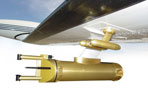 |
|
The DMT
Cloud Imaging Probe (CIP) is very similar in technical
operation to the 2D-OAP developed by PMS. A linear array
of laser beams is focused on a sampling area where the
particles’ shadows are optically magnified to provide
the imaging data. The data output is distributed in 62
channels making the minimum detectable particle size at
12.5 µm and the largest particle at 1562.5 µm. Particles
that shadow the two end diodes (1 and 64) are end rejected.
The CIP incorporates a Liquid Water Content (LWC) detector.
|
|
The DMT
Cloud Droplet Probe (CDP) is similar in technical operation
to the FSSP. The instrument counts and sizes individual
droplets as they traverse a laser beam. Droplets that
hit the laser beam within the sample volume scatter light
and the forward scattered light is collected onto an optical
beam splitter and then onto a pair of photo detectors,
the sizing detector and the qualifying detector. The range
of the CDP is fixed and the output is distributed in 30
size channels in the range of 2 µm to 50 µm.
|
|
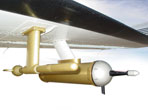 |
|
The
Aircraft Integrated Meteorological Measurement System
(AIMMS-20) gives up-to-the-second real-time
three-dimensional wind conditions evaluated using the Kalman Filter Digital Signal Processing (DSP)
technique. The AIMMS-20 consists of four components:
an Air Data Probe (ADP), a carrier-phase Geostationary
Positioning Satellite (GPS) measurement module, an
Inertial Measurement Unit (IMU) and Central Processing
Module (CPM).
|
|
The
Passive Cavity Aerosol Spectrometer Probe (PCASP
SPP-200) counts and sizes particles present in any
given volume of air within a specified size range.
Light scattered by a particle entering the PCASP laser
beam is collected and focused onto a photodetector
where it undergoes 3 stages of amplification to cover
the range between 0.1 and 3.0µm.
|
|
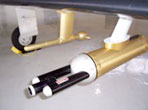 |
|
The
Forward Scattering Spectrometer Probe (FSSP SPP-100)
is also used to collect size distributions of airborne
particulates ranging from 2 - 47µm. For ease of
service and compatibility the probe mounts in the
7-inch OD cylinder as a plug-in assembly with two
internal connectors at 90° to each other allowing the
probe light tubes to be oriented either perpendicular
or parallel to the mounting pad.
|
|
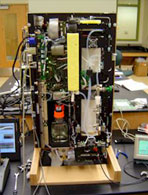 |
|
The
DMT CCN Counter samples aerosols from outside the
aircraft to measure their capability to act as cloud
condensation nuclei. An air sample is introduced in
the CCN chamber at the top center of a vertical
cylindrical column and is surrounded by an
aerosol-free humidified uniform supersaturation flow
environment. As the air sample flows down through the
chamber, CCN activate in response to the exposed
supersaturation and grow to droplets. An optical
particle counter at the base or outlet of the chamber
detects all particles with diameters larger than
0.5µm. The heart of the instrument is the 50 cm long
cylindrical column which provides the environment to
activate and grow aerosol particles. The column is
mounted vertically with the ambient aerosol entering
at the top, and the increase in supersaturation takes
place down the column. The unit operates at a single
supersaturation. The supersaturation depends on the
temperature difference between the top and bottom of
the column as well as the flow rate in the column. The
supersaturation can be varied between 0.07 % and 1.2
%. The column has three temperature control zones, for
rapid shifting between supersaturation. Approximately
30 seconds are required for a shift from one
supersaturation to another, although operation in the
field shows that shifting from a high supersaturation
(1.2 %) to a low supersaturation (0.07 %) may take
more than a minute since the temperature controllers
are more efficient at warming the column than at
cooling. The data output is distributed in 20 bins of
resolution over the sizing range of 0.75 µm to 10 µm.
The particle sizing data is updated at 1-second
intervals. At a sample flow rate of 60 vccm, 6000
particles per cubic centimeter can be counted with a
maximum of a 10 % coincidence.
|
|
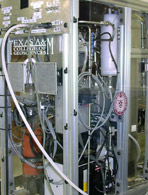 |
|
In a
Differential Mobility Analyzer (DMA), an electric
field of known magnitude is induced in order to
separate particles within a narrow electrical mobility
range. Size distribution of the particles ingested by
the DMA can be determined by scanning the voltage
applied to create the electric field, since particles
possessing one elementary charge demonstrate a unique
relationship between their electrical mobility and
their size. The TDMA is actually two DMAs in series
where the first DMA remains at a constant voltage and
produces a mono-dispersed aerosol which is then
subjected to a high relative humidity. If the aerosol
is hygroscopic, it will take up water and grow while
an aerosol that exhibits no hygroscopic properties
will exhibit no growth. The second DMA is applied a
voltage that is continuously scanned. Since the
ingested aerosol will flow from the first DMA to the
second, the known particle size separated by the first
DMA with the final size distribution measured by the
second DMA, the hygroscopic growth distribution of the
aerosol can be determined. Texas A&M University owns
and operates the TDMA.
|
|
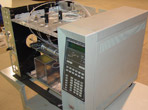
 |
|
The
Continuous Tracer (sulfur hexafluoride) Analyzer
allows for real-time, in-situ measurement of tracer
gas concentrations. Ambient air is mixed with hydrogen
and passed over a catalyst where oxygen and hydrogen
form water. The water is then removed from the gas
with a counter-current Nafion membrane drier and the
dry gas passes through an electron capture detector (ECD).
An HP 5890 gas chromatograph’s ECD and associated
electronics have been incorporated into the tracer
analyzer flow system. The ECD is a variable frequency
(pulse rate) which rises when an electron capturing
compound is passing through the cell. The pulse rate
is converted to a voltage, linearly related to amount
of electron capturing material in the cell. The output
is a 0-1 V analog signal.
|
|
This Parcel Tracking Software (PTS) was developed
and tested for cloud parcel tracking. The
capabilities of PTS are to:
1) accept the GPS coordinates of seeder aircraft
in flight and presents their tracks in real time
in the
cockpit of the cloud physics aircraft,
2) marks the positions of the seeder and cloud
physics aircraft and/or an event, such as the
detected
"hit" of SF6 gas and then repetitively navigates back to this
point as it drifts with the ambient wind,
3) display of LWC along the track of the cloud
physics aircraft when it was in cloud,
4) displays in real-time the plots of measured
aircraft parameters and presents the aircraft
navigation
information in a form useful to the pilot. |
|
|
|
|
| |
| |
| |
|
|